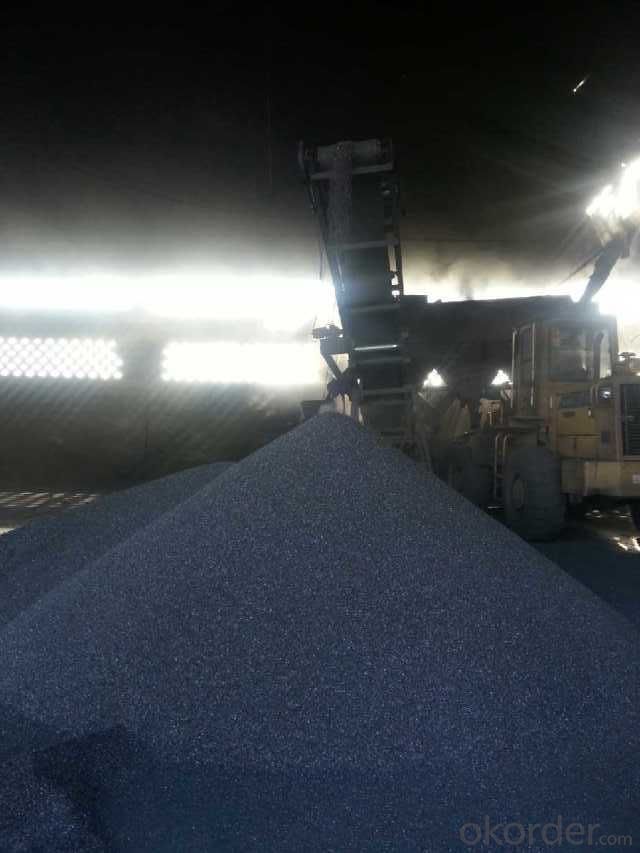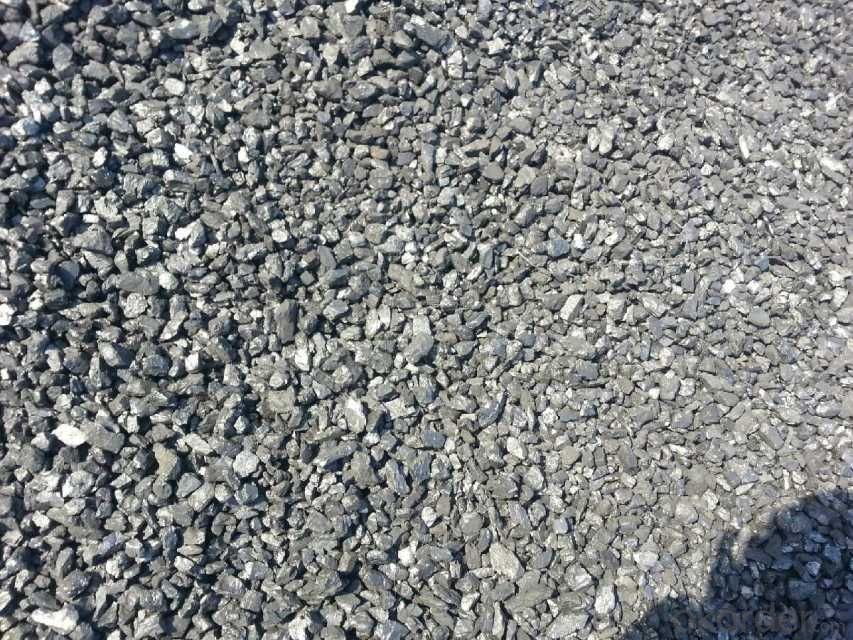FC93 Carbon Additive CNBM China Biggest Supplier
- Loading Port:
- Tianjin
- Payment Terms:
- TT OR LC
- Min Order Qty:
- 0 m.t.
- Supply Capability:
- 100000 m.t./month
OKorder Service Pledge
OKorder Financial Service
You Might Also Like
Packaging & Delivery
Packaging Detail: | 25kgs/50kgs/1ton per bag or as buyer's request |
Delivery Detail: | Within 20 days after receiving corect L/C |
Specifications
Calcined Anthracite
Fixed carbon: 90%-95%
S: 0.5% max
Size: 0-3. 3-5.3-15 or as request
Feature
All of our goods are made in the best quality of world famous Tianjin. All of our products are with High carbon, Low ash, low sulphur, Low Moisture.
Application
The Calcined Anthracite Coal/Gas Calcined Anthracite Coal/Carbon Raiser is mainly used in steelmaking in electrical stove, screening water, shipbuilding sandblast to remove rust. It can reduce the cost of steelmaking effectively by replacing the traditional petroleum coke of carburant.Also can improve the Carbon content in steel-melting and Ductile iron foundry.
Specifications
Calcined Anthracite
Fixed carbon: 90%-95%
S: 0.5% max
Size: 0-3. 3-5.3-15 or as request
PARAMETER UNIT GUARANTEE VALUE | |||||
F.C.% | 95MIN | 94MIN | 93MIN | 92MIN | 90MIN |
ASH % | 4MAX | 5MAX | 6MAX | 7MAX | 8MAX |
V.M.% | 1 MAX | 1MAX | 1.5MAX | 1.5MAX | 1.5MAX |
SULFUR % | 0.5MAX | 0.5MAX | 0.5MAX | 0.5MAX | 0.5MAX |
MOISTURE % | 0.5MAX | 0.5MAX | 0.5MAX | 0.5MAX | 0.5MAX |
Size can be adjusted based on buyer's request.



- Q:How does carbon contribute to global warming?
- The greenhouse effect, caused by carbon, contributes to global warming. When carbon dioxide (CO2) and other greenhouse gases are released into the atmosphere, they trap heat from the sun, preventing its escape into space. As a result, the Earth's surface temperature increases and global warming occurs. The primary cause of carbon emissions is the burning of fossil fuels such as coal, oil, and natural gas for energy production, transportation, and industrial processes. These activities release significant amounts of CO2 into the atmosphere, which accumulates over time and intensifies the greenhouse effect. Deforestation and changes in land use also play a role in rising carbon levels. Trees and plants absorb CO2 through photosynthesis, acting as a natural carbon sink. However, when forests are cleared, the stored carbon is released back into the atmosphere. Additionally, the loss of trees reduces the overall capacity for CO2 absorption, aggravating the problem. The consequences of increased carbon emissions are extensive. Rising temperatures lead to the melting of polar ice caps and glaciers, resulting in sea-level rise and posing a threat to coastal communities. Moreover, carbon-driven global warming disrupts weather patterns, giving rise to extreme weather events like hurricanes, droughts, and heatwaves. To mitigate the impact of carbon on global warming, efforts must be made to reduce carbon emissions. This can be accomplished by transitioning to renewable energy sources such as solar and wind power, enhancing energy efficiency, promoting sustainable practices in agriculture and forestry, and implementing policies that encourage carbon capture and storage. Addressing carbon emissions is vital in combating global warming and its associated consequences. By comprehending the role of carbon in the greenhouse effect, we can work towards a sustainable future that minimizes the adverse effects of climate change.
- Q:What is the role of carbon in the formation of diamonds?
- The role of carbon in the formation of diamonds is essential, as diamonds are composed entirely of carbon atoms arranged in a crystal lattice structure. The extreme heat and pressure deep within the Earth's mantle cause carbon atoms to bond tightly together, forming the unique structure of a diamond. Without carbon, diamonds would not exist.
- Q:What are the different types of carbon-based concrete additives?
- There are several different types of carbon-based concrete additives that can enhance the performance and properties of concrete. These additives are primarily derived from carbon-based materials and can be categorized into three main types: carbon nanotubes, graphene, and carbon fibers. 1. Carbon Nanotubes: These are cylindrical structures made up of carbon atoms arranged in a unique hexagonal pattern. Carbon nanotubes have exceptional mechanical and electrical properties, making them highly desirable as concrete additives. When added to concrete, they can improve its strength, durability, and toughness. Carbon nanotubes also enhance the electrical conductivity of concrete, which is beneficial for applications such as self-healing concrete and anti-static flooring. 2. Graphene: Graphene is a single layer of carbon atoms arranged in a two-dimensional lattice. It is known for its exceptional strength, high electrical conductivity, and excellent barrier properties. When incorporated into concrete, graphene can significantly improve its mechanical properties, such as compressive strength, flexural strength, and abrasion resistance. It also enhances the durability and impermeability of concrete, providing resistance against water and chemical ingress. 3. Carbon Fibers: These are long, thin strands of carbon, typically derived from organic polymers such as polyacrylonitrile or pitch. Carbon fibers possess excellent tensile strength and are widely used as reinforcements in various construction materials, including concrete. When added to concrete, carbon fibers can enhance its flexural strength, impact resistance, and cracking behavior. They also improve the ductility and toughness of concrete, making it more resistant to dynamic loads. It is worth noting that each type of carbon-based concrete additive has its unique advantages and applications. Carbon nanotubes offer exceptional mechanical and electrical properties, graphene provides enhanced strength and barrier properties, while carbon fibers enhance flexural strength and impact resistance. The choice of additive depends on the specific requirements of the concrete application and the desired performance characteristics.
- Q:Recently bought an alarm clock, it is recommended to use carbon batteries. Nanfu battery is not good for the movement.
- Yes, a lot of people do not pay attention to, the Nanfu battery, strange carbon batteries say it is really rare, generally small supermarkets are not only basic, and is strongly alkaline. Therefore, it is best to go to a large supermarket or electrical store try, there are generally sold there, and many types, the choice will be more.
- Q:How does carbon contribute to the strength of alloys?
- Carbon contributes to the strength of alloys by forming interstitial solid solutions with metals, which increases the hardness and strength of the material. The carbon atoms occupy the spaces between the metal atoms, creating lattice distortions and enhancing the overall strength of the alloy. Additionally, carbon can also form compounds with metals, such as carbides, which further improve the hardness and wear resistance of alloys.
- Q:Is badminton all good as carbon or aluminum carbon? Does carbon fiber on the Internet mean total carbon?
- The badminton racket is different in texture. Mainly divided into titanium, carbon, aluminum, carbon fiber, aluminum alloy and pure iron, pure aluminum. Among them, the best material is titanium, followed by carbon, aluminum, carbon fiber, aluminum alloy and pure iron, pure aluminum. Related knowledge: before 70s, the material is almost entirely of wood and steel in the world, in 70s began to use Aluminum Alloy, now the world is completely new materials such as carbon fiber, titanium alloy, high strength carbon fiber and other materials because they are lighter, stronger, more durable and can absorb more vibration and shock, at the same time let the racket maker the hardness of the racket, ball, have more space to play ball on the performance design. When choosing the racket, best to look at this is what a racket made of material, usually in the racket racket rod and a racket frame will be labeled with the material, sometimes is the same as YONEX ISO-800TOUR High Modulus Graphite shot rod (high strength carbon fiber) frame also has the same mark, and some racket racket rod and frame material is not the same as: YONEX ISO-250LONG High Moudulus Graphite shot frame for Graphite (carbon fiber). Some also took pole, beat box made of the same material the labeled All Graphite or All Graphite racket only in a local frame or shaft. Sign formal products are accurate and reliable, and fake products marked is printed, it is generally used in relatively poor carbon cloth, compared the density, purity and regular products so large that the cost is very low.
- Q:How does carbon impact ocean acidity?
- Carbon impacts ocean acidity through a process called ocean acidification. When carbon dioxide (CO2) from human activities is emitted into the atmosphere, a significant portion of it is absorbed by the ocean. Once in the ocean, CO2 reacts with water to form carbonic acid, which lowers the pH of seawater, making it more acidic. This increased acidity can have detrimental effects on marine life, particularly on shell-forming organisms like corals, mollusks, and some plankton, as it hampers their ability to build and maintain their calcium carbonate structures. Additionally, ocean acidification disrupts the delicate balance of marine ecosystems, affecting various species and ultimately impacting the entire food chain.
- Q:Is carbon a solid, liquid, or gas at room temperature?
- Carbon is a solid at room temperature.
- Q:How is carbon used in the water treatment process?
- Carbon is used in the water treatment process as a highly effective adsorbent to remove organic compounds, chemicals, and impurities from water. It acts as a filter by trapping contaminants on its surface, improving the taste and odor of water and making it safe for consumption.
- Q:What is carbon?
- Life on Earth depends on carbon, a chemical element that is found in all living organisms. It serves as the foundation for the organic compounds that compose our bodies, including proteins, carbohydrates, lipids, and nucleic acids. Carbon can be found in different forms, such as graphite and diamonds, and has the remarkable ability to form strong bonds with other elements. This versatility makes it essential in various natural processes like photosynthesis, respiration, and the carbon cycle, which helps regulate the Earth's climate. Moreover, carbon plays a significant role in industry, where it is utilized as a raw material for producing fuels, plastics, and countless other goods. Overall, carbon is a crucial element that sustains life and drives numerous chemical and biological processes.
1. Manufacturer Overview |
|
|---|---|
| Location | |
| Year Established | |
| Annual Output Value | |
| Main Markets | |
| Company Certifications | |
2. Manufacturer Certificates |
|
|---|---|
| a) Certification Name | |
| Range | |
| Reference | |
| Validity Period | |
3. Manufacturer Capability |
|
|---|---|
| a)Trade Capacity | |
| Nearest Port | |
| Export Percentage | |
| No.of Employees in Trade Department | |
| Language Spoken: | |
| b)Factory Information | |
| Factory Size: | |
| No. of Production Lines | |
| Contract Manufacturing | |
| Product Price Range | |
Send your message to us
FC93 Carbon Additive CNBM China Biggest Supplier
- Loading Port:
- Tianjin
- Payment Terms:
- TT OR LC
- Min Order Qty:
- 0 m.t.
- Supply Capability:
- 100000 m.t./month
OKorder Service Pledge
OKorder Financial Service
Similar products
New products
Hot products
Related keywords





























